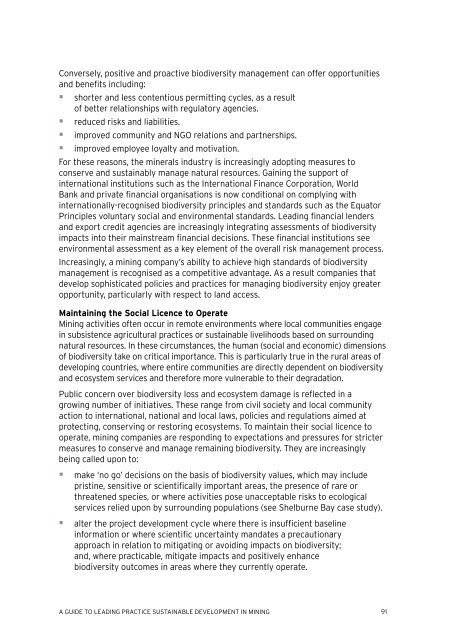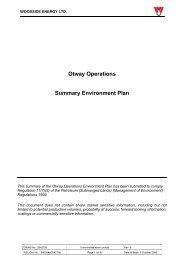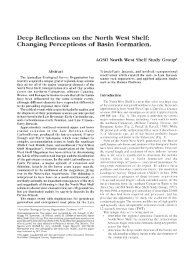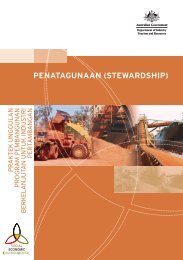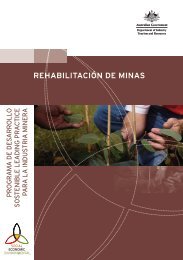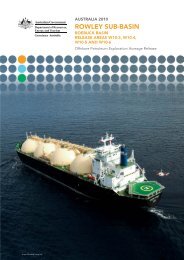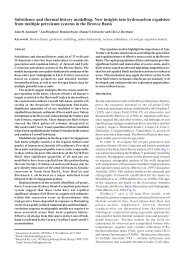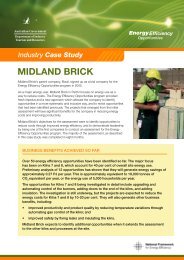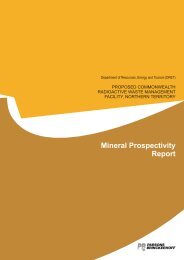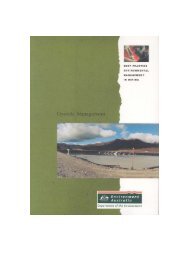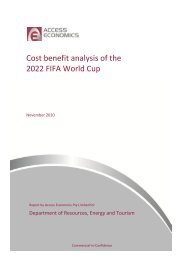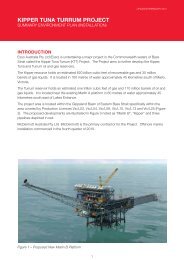A guide to leading practice sustainable development in mining
A guide to leading practice sustainable development in mining
A guide to leading practice sustainable development in mining
You also want an ePaper? Increase the reach of your titles
YUMPU automatically turns print PDFs into web optimized ePapers that Google loves.
Conversely, positive and proactive biodiversity management can offer opportunities<br />
and benefits <strong>in</strong>clud<strong>in</strong>g:<br />
shorter and less contentious permitt<strong>in</strong>g cycles, as a result<br />
of better relationships with regula<strong>to</strong>ry agencies.<br />
reduced risks and liabilities.<br />
improved community and NGO relations and partnerships.<br />
improved employee loyalty and motivation.<br />
For these reasons, the m<strong>in</strong>erals <strong>in</strong>dustry is <strong>in</strong>creas<strong>in</strong>gly adopt<strong>in</strong>g measures <strong>to</strong><br />
conserve and susta<strong>in</strong>ably manage natural resources. Ga<strong>in</strong><strong>in</strong>g the support of<br />
<strong>in</strong>ternational <strong>in</strong>stitutions such as the International F<strong>in</strong>ance Corporation, World<br />
Bank and private f<strong>in</strong>ancial organisations is now conditional on comply<strong>in</strong>g with<br />
<strong>in</strong>ternationally-recognised biodiversity pr<strong>in</strong>ciples and standards such as the Equa<strong>to</strong>r<br />
Pr<strong>in</strong>ciples voluntary social and environmental standards. Lead<strong>in</strong>g f<strong>in</strong>ancial lenders<br />
and export credit agencies are <strong>in</strong>creas<strong>in</strong>gly <strong>in</strong>tegrat<strong>in</strong>g assessments of biodiversity<br />
impacts <strong>in</strong><strong>to</strong> their ma<strong>in</strong>stream f<strong>in</strong>ancial decisions. These f<strong>in</strong>ancial <strong>in</strong>stitutions see<br />
environmental assessment as a key element of the overall risk management process.<br />
Increas<strong>in</strong>gly, a m<strong>in</strong><strong>in</strong>g company’s ability <strong>to</strong> achieve high standards of biodiversity<br />
management is recognised as a competitive advantage. As a result companies that<br />
develop sophisticated policies and <strong>practice</strong>s for manag<strong>in</strong>g biodiversity enjoy greater<br />
opportunity, particularly with respect <strong>to</strong> land access.<br />
Ma<strong>in</strong>ta<strong>in</strong><strong>in</strong>g the Social Licence <strong>to</strong> Operate<br />
M<strong>in</strong><strong>in</strong>g activities often occur <strong>in</strong> remote environments where local communities engage<br />
<strong>in</strong> subsistence agricultural <strong>practice</strong>s or <strong>susta<strong>in</strong>able</strong> livelihoods based on surround<strong>in</strong>g<br />
natural resources. In these circumstances, the human (social and economic) dimensions<br />
of biodiversity take on critical importance. This is particularly true <strong>in</strong> the rural areas of<br />
develop<strong>in</strong>g countries, where entire communities are directly dependent on biodiversity<br />
and ecosystem services and therefore more vulnerable <strong>to</strong> their degradation.<br />
Public concern over biodiversity loss and ecosystem damage is reflected <strong>in</strong> a<br />
grow<strong>in</strong>g number of <strong>in</strong>itiatives. These range from civil society and local community<br />
action <strong>to</strong> <strong>in</strong>ternational, national and local laws, policies and regulations aimed at<br />
protect<strong>in</strong>g, conserv<strong>in</strong>g or res<strong>to</strong>r<strong>in</strong>g ecosystems. To ma<strong>in</strong>ta<strong>in</strong> their social licence <strong>to</strong><br />
operate, m<strong>in</strong><strong>in</strong>g companies are respond<strong>in</strong>g <strong>to</strong> expectations and pressures for stricter<br />
measures <strong>to</strong> conserve and manage rema<strong>in</strong><strong>in</strong>g biodiversity. They are <strong>in</strong>creas<strong>in</strong>gly<br />
be<strong>in</strong>g called upon <strong>to</strong>:<br />
make ‘no go’ decisions on the basis of biodiversity values, which may <strong>in</strong>clude<br />
prist<strong>in</strong>e, sensitive or scientifically important areas, the presence of rare or<br />
threatened species, or where activities pose unacceptable risks <strong>to</strong> ecological<br />
services relied upon by surround<strong>in</strong>g populations (see Shelburne Bay case study).<br />
alter the project <strong>development</strong> cycle where there is <strong>in</strong>sufficient basel<strong>in</strong>e<br />
<strong>in</strong>formation or where scientific uncerta<strong>in</strong>ty mandates a precautionary<br />
approach <strong>in</strong> relation <strong>to</strong> mitigat<strong>in</strong>g or avoid<strong>in</strong>g impacts on biodiversity;<br />
and, where practicable, mitigate impacts and positively enhance<br />
biodiversity outcomes <strong>in</strong> areas where they currently operate.<br />
A GUIDE TO LEADING PRACTICE SUSTAINABLE DEVELOPMENT IN MINING 91


